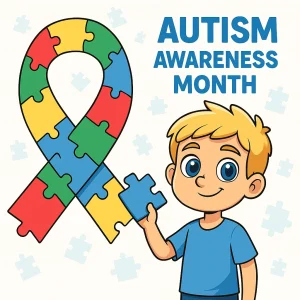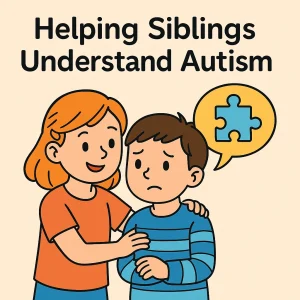Virtual Autism in Children: Real Concern or Screen Myth?
By Rajini D
Last Updated: May 18, 2024
In today’s world, digital devices are everywhere. A new worry called Virtual Autism is being talked about by parents, teachers, and doctors. It’s not an official medical condition like Autism Spectrum Disorder (ASD), but it’s a name for when kids act a lot like they have ASD because they’re using screens too much. In our time, where screens are like friends, teachers, and caretakers all rolled into one, we’re starting to see that too much screen time is a problem we must face.
Looking closer at Virtual Autism, we see why many experts worry. The online world is full of things to learn and fun, but it can also be a problem if kids use it too much. Parents are trying to find a balance. They want to use technology to help their kids learn but also to ensure they aren’t on their devices so much that it stops them from growing up healthy.
Understanding Autism
What Is Virtual Autism?
Imagine a world where screens become the primary interaction point for a child. Here, in this digital realm, virtual autism takes root. It’s a condition observed in young children who exhibit autism-like symptoms after spending excessive time engaged with screens. This isn’t about an occasional cartoon or a learning app session; it’s about prolonged, often unsupervised, screen time that replaces physical play, exploration, and face-to-face interactions.
Know more about Understanding & Parenting an Autistic Child: Guide & Tips
Symptoms of Virtual Autism
Notice your child displaying a decreased ability to engage in cognitive activities, showing signs of hyperactivity, experiencing speech delays, or losing interest in physical play. It might be time to observe their screen time closely. These symptoms of Virtual Autism in Children underscore the importance of early recognition. Spotting these signs isn’t about labeling or diagnosing; it’s about understanding your child’s needs better and adjusting their environment to support their growth.
Causes and Contributing Factors
The primary suspect in the rise of Virtual Autism? Excessive screen time. Expert insights reveal that children’s brains are like sponges, absorbing everything around them. When their environment is largely digital, their developmental trajectory can veer toward the symptoms we associate with Virtual Autism in Children. Not just the quantity of screen time that’s concerning, but also the quality and the decrease in real-world interactions. Using screens as digital pacifiers during meals, travel, or to quell boredom can inadvertently contribute to this phenomenon.
Also Read: Tech De-addiction | How to Put Off the Child from Gadgets? | How to Unplug My Kid?
The Impact of the Digital World
The digital world, with its infinite reservoir of information and entertainment, offers unparalleled opportunities for learning and development. However, the shadow it casts on children’s developmental journey cannot be overlooked. The overuse of digital devices is not just a matter of concern; it’s becoming a pivotal factor influencing young minds’ behavioral and cognitive development.
The Pandemic Effect: Accelerating Digital Dependence
The advent of the COVID-19 pandemic has magnified this issue significantly. With lockdowns and social distancing norms in place, screens became the windows to the outside world for adults and children alike. Educational institutions transitioned to online platforms, recreational activities shifted to virtual spaces, and digital devices mediated social interactions. This sudden and prolonged immersion into the digital realm has raised alarms about its impact on children’s social, emotional, and cognitive development.
Virtual Autism: A Pandemic Within a Pandemic
The term ‘Virtual Autism,’ as we’ve explored, embodies the spectrum of behavioral changes emerging from excessive screen exposure. The pandemic has inadvertently served as a catalyst, accelerating the prevalence of these symptoms among children. While screens have been instrumental in maintaining a semblance of normalcy during these unprecedented times, the escalation in screen time has also exposed children to the risks of developing symptoms associated with Virtual Autism.
Strategies for Prevention and Management
Navigating the digital landscape with children requires thoughtful strategies to ensure healthy development. Here, we present practical tips and engaging activities that reduce screen time and promote enriching real-world interactions, focusing on how Wellness Hub supports parents in this crucial endeavor.
Reducing Screen Time
- Establish Clear Guidelines: Set specific limits on screen time tailored to your child’s age and needs. Implement “screen-free zones” in the home, particularly in bedrooms and dining areas, to encourage family interaction.
- Be a Role Model: Children emulate their parents. Show them the value of being present and engaged in the moment by limiting your own screen time, especially during family gatherings.
- Schedule Screen Time: Treat screen time like any other activity – with a designated time and duration. This helps children understand that it’s a part of their day, not the entirety of it.
- Tech-Free Activities: Encourage hobbies that don’t require screens. Whether painting, reading, or outdoor sports, finding passions outside the digital realm can be incredibly fulfilling.
Screen Time Guidelines by Age
| Age Group | Recommended Screen Time |
|---|---|
| Under 2 years | One hour of high-quality programming: Children aged between 2 and 5 years should be limited to no more than one hour per day of screen time. This should consist of high-quality programming or apps where parents watch and engage with their children. This provides educational benefits and ensures that screen time does not replace critical activities like physical play, sleep, and caregiver interaction. |
| 2-5 years | One hour of high-quality programming: Children aged between 2 and 5 years should be limited to no more than one hour per day of screen time. This should consist of high-quality programming or apps where parents watch and engage with their children. This provides educational benefits and ensures that screen time does not replace critical activities like physical play, sleep, and interaction with caregivers. |
| 6 years and older | Consistent limits on screen time, ensuring time for healthy physical activity: For children aged 6 years and older, there is no specific hour limit, but it’s crucial to maintain consistent limits on the amount of screen time. The focus should be on ensuring that screen time does not interfere with adequate physical activity, sleep, and other behaviors essential to health. Parents are encouraged to set consistent boundaries and ensure that screen time is balanced with productive and healthy activities. |
Read more: How does screen time affect your child’s development?
Promoting Real-World Interactions
- Outdoor Adventures: Nature offers endless opportunities for learning and play. Plan regular family outings to parks, beaches, or trails. These excursions are good for physical health and emotional and social development.
- Creative Play: Allocate time for activities that spark creativity, such as arts and crafts, storytelling, or music. Engaging in creative play helps develop critical thinking and problem-solving skills.
- Social Playdates: Encourage your child to have in-person playdates with peers. Social interaction is crucial for developing empathy, communication skills, and understanding social cues.
Wellness Hub’s Role
At Wellness Hub, we understand parents’ challenges in balancing digital and real-life experiences for their children. We offer a plethora of resources designed to support families in this journey. From expert articles on managing screen time to activities that promote physical and mental wellness. Our platform also features tools for creating personalized plans that align with your child’s needs and interests, ensuring that you have the support needed to make informed decisions about your child’s screen time and overall well-being.
Conclusion
In today’s world, it’s crucial for parents to monitor how much time their children spend with digital devices. The idea of Virtual Autism has brought attention to this. It shows us the importance of balancing screen time with other activities. We want them to enjoy the digital world but also love the real world around them.
Wellness Hub is here to help families find that balance. We offer tips and resources to make managing screen time easier. With our support, you can ensure that technology is a positive part of your child’s life. Let’s work together to ensure our children use screens in healthy ways so they can be their best selves in both the digital and real worlds.
Frequently Asked Questions:
1. What is Virtual Autism in Children?
Virtual Autism refers to a set of behaviors and symptoms in children that are similar to those of Autism Spectrum Disorder (ASD), stemming from excessive screen time. It’s important to note that Virtual Autism is not a clinical diagnosis but highlights concerns regarding the developmental impact of prolonged digital device use in children.
2. How Can Excessive Screen Time Affect My Child?
Excessive screen time can lead to symptoms such as decreased cognitive ability, hyperactivity, speech delays, and reduced interest in physical activities. It may also impact a child’s social skills and emotional development by limiting real-world interactions.
3. What Are the Signs of Virtual Autism?
Signs of Virtual Autism include but are not limited to lack of focus, irritability, mood swings, speech and language impairment, and a preference for the virtual world over physical play or interaction with others.
4. Can Virtual Autism Be Prevented or Reversed?
Yes, by managing screen time effectively and encouraging more real-world interactions, parents can mitigate the effects of Virtual Autism. Activities that promote physical play, creativity, and social interaction are beneficial.
5. How Much Screen Time is Considered Safe for Children?
Screen time guidelines vary by age. It’s recommended that children under 2 avoid digital media other than video chatting, while children aged 2 to 5 should be limited to one hour of screen time per day. For older children, it’s crucial to balance screen time with physical and creative activities.
6. What Strategies Can Parents Use to Reduce Screen Time?
Strategies include establishing clear screen time guidelines, creating screen-free zones at home, scheduling tech-free activities, and leading by example by reducing your own screen usage.
7. How Does Wellness Hub Support Families in Managing Screen Time?
Wellness Hub offers a variety of resources and tools to help parents balance their children’s digital and real-life experiences. From expert articles to activities designed to engage children away from screens, Wellness Hub is dedicated to supporting families in fostering healthy development.
8. What Activities Can Help Offset the Effects of Screen Time?
Engaging children in activities that stimulate their physical, cognitive, and social development is key. This can include outdoor play, arts and crafts, reading together, and social playdates with peers. These activities help develop skills and interests beyond the digital realm.
9. How Can Parents Monitor Their Child’s Screen Time?
Parents can use a variety of methods to monitor screen time, including setting up parental controls on devices, using apps that track screen usage, and creating a family media plan that outlines when and how screens can be used at home.
10. Are There Any Positive Effects of Screen Time on Children?
Yes, when used appropriately, screen time can have educational benefits for children, such as access to quality content that supports learning and creativity. The key is to ensure that screen time is balanced with other activities and that the content is age-appropriate and engaging in a constructive way.
About the Author:
Rajini Darugupally
M.Sc., Speech-Language Pathologist (9+ years of experience)
Rajini is a passionate and dedicated Speech-Language Pathologist with over 9+ years of experience, specializing in both developmental speech and language disorders in children and rehabilitation in adults. Driven by a desire to empower each individual to find their voice, Rajini brings a wealth of experience and a warm, genuine approach to therapy.
Currently, at Wellness Hub, she thrives in a team environment that values innovation, compassion, and achieving results for their clients.
Connect with Rajini to learn more about how she can help you or your loved one find their voice.
Book your Free Consultation Today
Parent/Caregiver Info:
Client’s Details:
* Error Message









